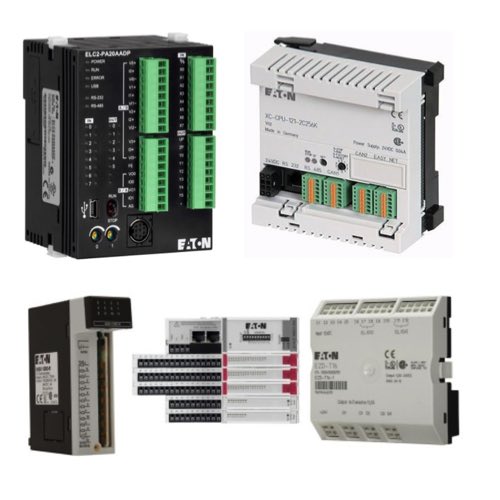Eaton PLCs

RSP Supply carries a full line of Eaton PLCs designed for reliable and efficient industrial automation. Eaton programmable logic controllers deliver precise monitoring and control for manufacturing, process, and power distribution systems, helping facilities reduce downtime and improve operational performance.
Eaton PLCs are solid-state control devices capable of monitoring and managing input and output signals from a wide range of sensors, switches, and industrial components. Available in nano, compact, and modular designs, these PLCs provide scalable control solutions for everything from small machines to complex plant-wide systems.
The easyE4 nano PLC provides flexible control for small applications, while the XC compact PLC line integrates high-performance logic and communication features in a space-saving design. For larger and more complex automation networks, the XC modular PLC system allows for scalable expansion and advanced connectivity through the XN300 I/O platform, giving engineers the ability to tailor systems precisely to operational needs. Eaton PLCs offer precise control, fast response times, and robust communication options, making them an ideal choice for wastewater treatment, manufacturing, energy management, and building automation. Their modular flexibility and compatibility with industry protocols ensure that these controllers can adapt to the evolving demands of modern industrial automation.
FAQs
Q: What types of Eaton PLCs are available?
Eaton offers nano, compact, and modular PLCs, including the easyE4, XC, and XC300 series, to support applications of varying complexity and scale.
Q: What is the difference between modular and brick PLCs?
Modular PLCs can be expanded with additional I/O modules and communication interfaces, while brick PLCs are self-contained units ideal for fixed-function applications.
Q: What communication options are available for Eaton PLCs?
Eaton PLCs support multiple industrial communication protocols such as Modbus, Ethernet/IP, and CANopen for seamless integration into automation systems.
Q: Can Eaton PLCs be used in harsh industrial environments?
Yes. Eaton PLCs are designed for demanding industrial settings, offering high durability, electromagnetic resistance, and reliable operation under extreme conditions.
Q: Are Eaton PLCs compatible with Eaton’s I/O systems?
Yes. Eaton PLCs integrate easily with Eaton’s XN300 I/O systems, providing flexible expansion for large or distributed control applications.
Why Buy Eaton PLCs from RSP Supply
RSP Supply offers a complete selection of Eaton PLCs, including the easyE4, XC, and XC300 series. We provide competitive pricing, fast shipping, and knowledgeable support to help you choose the right automation solution for your system. With RSP Supply, you get trusted products, reliable delivery, and expert service that help keep your industrial processes running smoothly.

